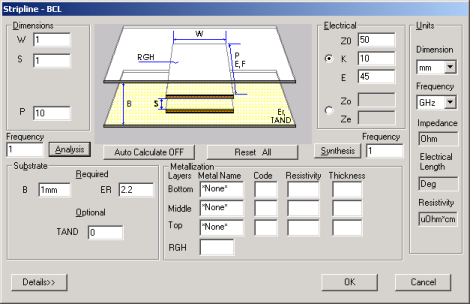|
微波射频仿真设计 |
|
|
微波射频仿真设计 |
|
| 首页 >> Ansoft Designer >> Ansoft Designer在线帮助文档 |
|
Transmission Line Designer > Broadside-Coupled Stripline Transmission Lines
Synthesis and AnalysisTwo options exist for synthesis of broadside-coupled stripline transmission lines: — Specify impedance, Z0, and the coupling coefficient, K. — Specify even-mode impedance, Ze, and odd-mode impedance, Zo. • The substrate parameters B, and ER must be entered prior to clicking the Synthesis button. The width of the striplines, W, and the spacing between them, S, will be computed. Also, the alternate electrical option set will be computed (e.g., if Z0 and K are entered, Ze and Zo will be computed). • For analysis, the parameters W, S, B, and ER must be entered prior to clicking the Analysis button. The electrical properties, Z0, K, Zo, and Ze will be computed. The frequency will be used if entered; otherwise, 0 Hz will be used in the calculation. • Conversion from electrical length, E, to physical length, P, can be performed by entering values for E and Frequency. Click Synthesis to compute P. Similarly, to convert from physical length to electrical length, enter values for P and Frequency, and click Analysis to compute E.
Dielectric SubstratesA dielectric substrate is defined by the parameters B, ER, and TAND. The substrate is assumed to be lossless unless TAND is specified and greater than zero.
Conductor Metallization• Conductor specification is performed in the Metallization control group. If the conductor is not specified, the conductor loss is zero and no thickness corrections are made to the structure’s propagation characteristics. Up to three conductors of different metals and thicknesses can be specified. • Metallization rms surface roughness, RGH, can be specified for additional conductor losses due to imperfect metal surfaces. RGH is specified in terms of rms variation from an ideal flat surface.
Sweep OptionsParameters that can be swept for the broadside-coupled striplines are: Frequency The order shown is the order used to generate output data when multiple parameters are swept simultaneously. Refer to the section on Sweep Entries for further information.
LimitationsTo maintain accuracy, the following limitations should be followed:
and
ExampleTo select the broadside-coupled stripline medium, select TRL on the Product menu, click Stripline, and click BCL. Set the units to mm and GHz. We will use the following parameters to synthesize a 6-dB coupler at 10 GHz: Impedance, Z0: 50 ohms Coupling, K: 6 dB Frequency: 10 GHz Substrate thickness, B: 1.27 mm Dielectric constant, ER: 2.2 Metal: Cu 0.01 mm
Click the Synthesis button to determine the coupler’s parameters: Width, W: 0.764 mm Spacing, S: 0.294 mm Odd-mode impedance, Zo: 28.82 ohms Even-mode impedance, Ze: 86.74 ohms To specify a 1/4 wavelength line, enter: Electrical length, E: 90
Click Synthesis again to determine the line’s physical length: Physical length, P: 5.05 mm
A sweep analysis can be performed on W, S, or Frequency. To perform a sweep analysis on W, type 0.5,1.0,0.05 in the W field to specify a sweep from 0.5 mm to 1.0 mm in steps of 0.05 mm. Clicking Analysis then yields the following results:
Broadside Coupled Strip Lines B = 1.270mm ER = 2.20 TAND = 0.00000 T/B = 0.0079
Freq S/B W/B ZE ZO Cond + Diel Loss (dB/mm ) ghz Ohms Ohms Even Mode Odd Mode
10.0 0.234 0.394 107.0 39.4 0.0016 0.0048 10.0 0.234 0.434 102.4 36.8 0.0015 0.0047 10.0 0.234 0.474 98.1 34.5 0.0014 0.0045 10.0 0.234 0.514 94.3 32.5 0.0014 0.0044 10.0 0.234 0.554 90.7 30.7 0.0013 0.0042 10.0 0.234 0.594 87.4 29.1 0.0012 0.0041 10.0 0.234 0.635 84.3 27.7 0.0012 0.0040 10.0 0.234 0.675 81.4 26.4 0.0012 0.0039 10.0 0.234 0.715 78.7 25.2 0.0011 0.0039 10.0 0.234 0.755 76.2 24.1 0.0011 0.0038 10.0 0.234 0.787 74.3 23.3 0.0010 0.0037
The variation of impedance and loss with conductor width is readily apparent.
HFSS视频教程 ADS视频教程 CST视频教程 Ansoft Designer 中文教程 |
|
Copyright © 2006 - 2013 微波EDA网, All Rights Reserved 业务联系:mweda@163.com |
|